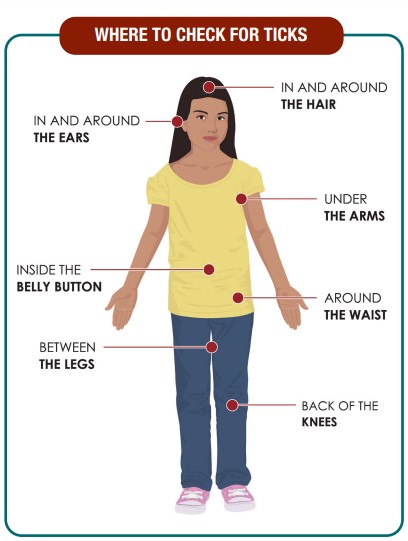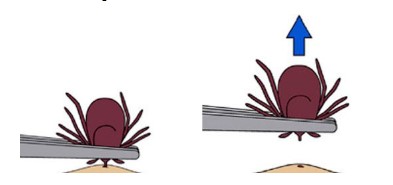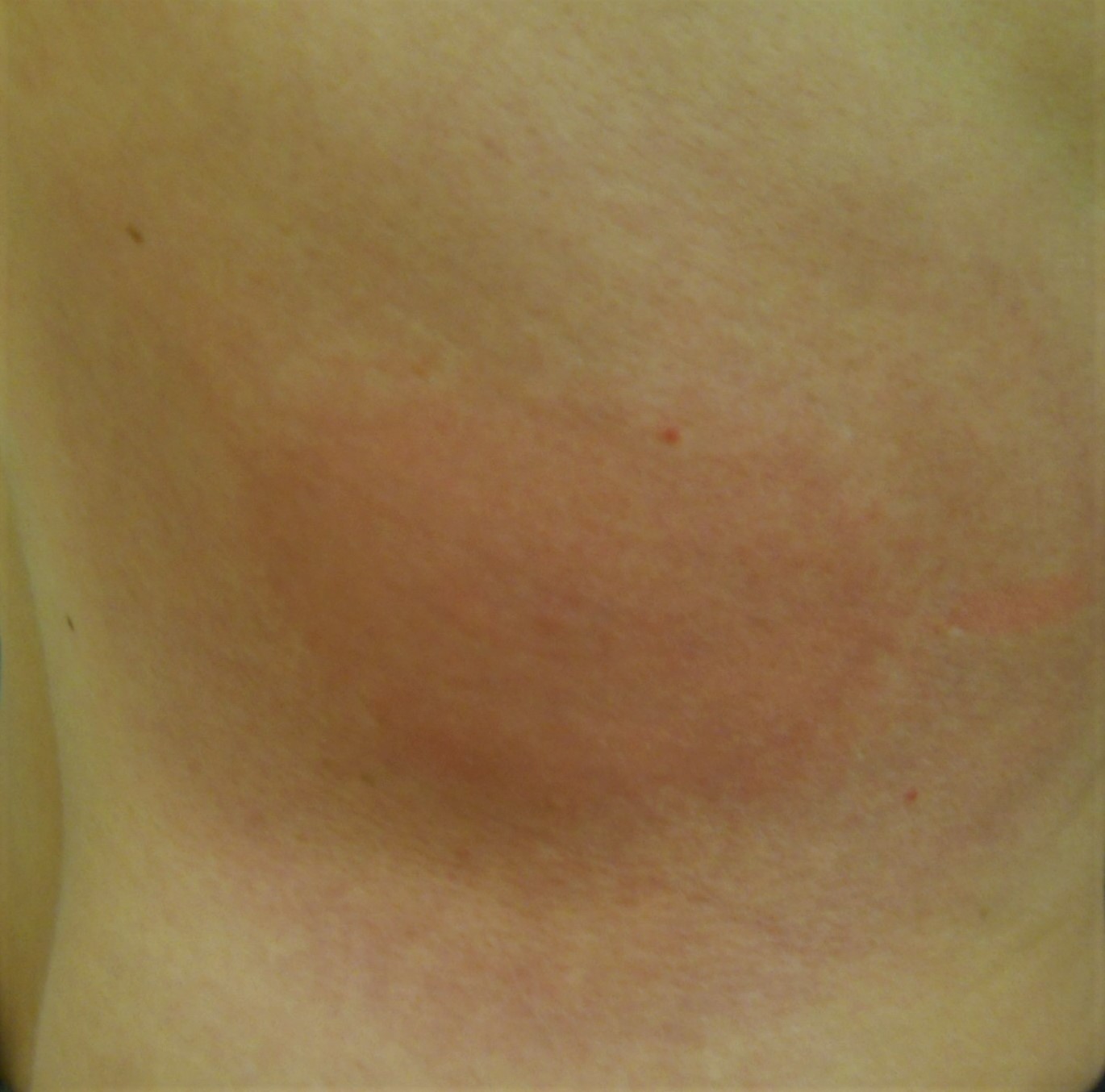PREVENTION TIPS
While outside walking, hiking, playing sports, gardening or relaxing, please be aware of ticks and the GEOGRAPHIC EXPANSION of Lyme disease. Enjoy the outdoors safely by using these PREVENTION TIPS to minimize your risk of Lyme disease and tick borne diseases.
- Create a tick free zone around your house
- When on a trail, stay on the path and away from tall grass
- Use tick repellents on your skin and spray your clothes with permethrin
- Perform daily tick checks
- Remove ticks immediately with a tweezer
Do you know what to do if you’re bitten by a tick?
Finding and Removing a Tick
You can’t get sick from a tick that is crawling on you but has not yet attached. Ticks must bite you to spread their germs. Do a full body check for ticks, especially the spots indicated here:

Tick attachment time is important. If the tick is attached it will be hard to pull off. Removing ticks as soon as possible reduces the risk of infection.
If you or a loved one is bitten, remove the tick promptly.
Here’s how:

- Grasp the tick’s mouthparts against the skin, using pointed tweezers.
- Pull steadily without twisting until you can ease the tick head straight out of the skin.
- DO NOT pull back sharply; this may tear the mouthparts from the body of the tick and leave them embedded in the skin.
- If this happens, don’t panic! Embedded mouthparts do not transmit Lyme disease.
- DO NOT squeeze or crush the body of the tick; this may force infected body fluids from the tick into the skin.
- DO NOT apply substances such as petroleum jelly, nail polish, or a lighted match to the tick while it is attached. They may agitate the tick and force more infected fluid into the skin.
- Once you have removed the tick, wash the wound site and your hands with soap and water, and apply rubbing alcohol or antiseptic to the site.
- If you have found a tick on you, it’s a sign there may be others. Do a careful tick check.
- Observe the bite site over the next two weeks for any signs of an expanding red rash or flu-like symptoms. (see below)
- Take a photo of the tick and of the rash throughout its presentation.
- Consult with your PCP about sending your tick to a lab, such as TickCheck or TickEncounter, to be tested for pathogens.
Receiving Care
Following a tick bite it is important to watch for an expanding red rash or lesion at the site of the tick bite and/or an unexplained feverish, achy, fatiguing illness within 1 to 4 weeks after the bite. Be particularly vigilant if you travel to or live in an area where Lyme disease is common.
Call your healthcare provider if you have flu-like symptoms and/or a suspicious rash.
- Rash
- Fever
- Fatigue
- Headache
- Muscle pain
- Joint swelling and pain
Can you recognize the different appearances of a Lyme disease rash? Although a bull’s eye rash is a tell-tale for Lyme disease, it is NOT the most common presentation of a Lyme disease rash.
Be sure to take a photo of your rash each day to monitor its size and appearance.

If you have been bitten by a tick and have an active ongoing rash, call 410-870-5963 to schedule an urgent in-person rash evaluation appointment at the Johns Hopkins Lyme Disease Research Center and Clinical Care Program.
Ticks can transmit multiple pathogens in one bite. Although Borrelia burgdorferi (the agent of Lyme disease) is the most common tick borne pathogen, other tick borne agents can be transmitted as well. Antibiotic treatment for a Borrelia burgdorferi infection is most effective if given early. In general, the CDC does not recommend taking a single prophylactic dose of antibiotic after a tick bite to reduce the risk of tick borne disease. Treatment options should be discussed with your healthcare provider.
Bitten by a tick and have an active ongoing rash? Call our RASH HOTLINE at 410-870-5963 for a rash evaluation appointment.
Diagnosing Lyme Disease:
- Lyme disease is a clinical diagnosis made by a doctor or nurse by examining the patient.
- Acute Lyme disease is not a laboratory diagnosis; a negative Lyme blood test does not exclude Lyme disease in the first few weeks of the illness.
- Many with Lyme disease have a flu-like illness and NO rash.
- Fever, aches, and abrupt and severe fatigue can be the main symptoms of acute Lyme.
- Lyme disease is different from a respiratory “cold”.
- A runny nose and prominent cough are NOT symptoms of Lyme disease.
- Blood tests do not accurately diagnose Lyme disease in the first few weeks of infection, so being vigilant about looking for symptoms is a more reliable way to identify an early case of Lyme disease.
If you have additional questions, please contact your Primary Care Physician or health care provider to discuss.
Background
- Lyme disease is a worldwide tickborne epidemic.
- There are approximately half a million new Lyme disease cases each year in the US.
- Lyme disease is a multi-system bacterial infection transmitted to humans through the bite of an infected deer tick.
- Ticks can transmit numerous different pathogens.
- Every age is at risk for contracting Lyme disease and tickborne illness.
- Early diagnosis enables early treatment and the best prognosis.
- Delayed treatment is associated with higher risk for persistent symptoms.
- Persistent symptoms include disabling pain, fatigue and cognitive impairment.
Suspicious Rash or Flu-Like Symptoms?
If you have a suspicious expanding red circular rash and/or flu-like symptoms such as fever, achiness, extreme fatigue, severe headache or neckache, this could be acute Lyme disease. Please seek medical care immediately.


